admin
Staff member
The 2022 Kawasaki Ninja H2R: a Ninja on Steroids
Contents
The 2023 Kawasaki Ninja H2R is a beastly hypersport that allows you to take your riding experience to the next level as the “middle” sibling of the H2 family in the 2023 Kawasaki lineup. This machine is not for beginners, as it is packed with a 998 cc supercharged engine that delivers horsepower and 121 lb-ft of torque! With a lightweight chassis and aerodynamic bodywork, the Ninja H2R is built for speed and performance, whether on the track or cruising on the open road. With a top speed of around 240 mph, Kawasaki has proven it’s the top in power and performance compared to the other Japanese brands.
Helping to keep things in control, the H2R includes a multitude of electronic controls to aid the rider. From braking controls, traction control and launch control, you can adjust settings to your riding style. Keeping the chassis sorted is the top of the line, fully adjustable inverted forks and the Ohlins TTX36 rear shock. When it comes time to stop the beast, there’s no problem considering the dual radial-mount 4 piston Brembos working dual 330mm discs. This motorcycle is the perfect choice for adrenaline junkies who crave the ultimate riding experience.
The 2023 Kawasaki Ninja H2R starts at $57,500 USD / $66,900 CAD
On this page: we’ve curated specs, features, news, photos/videos, etc. so you can read up on the new 2023 Kawasaki Ninja H2R in one place.
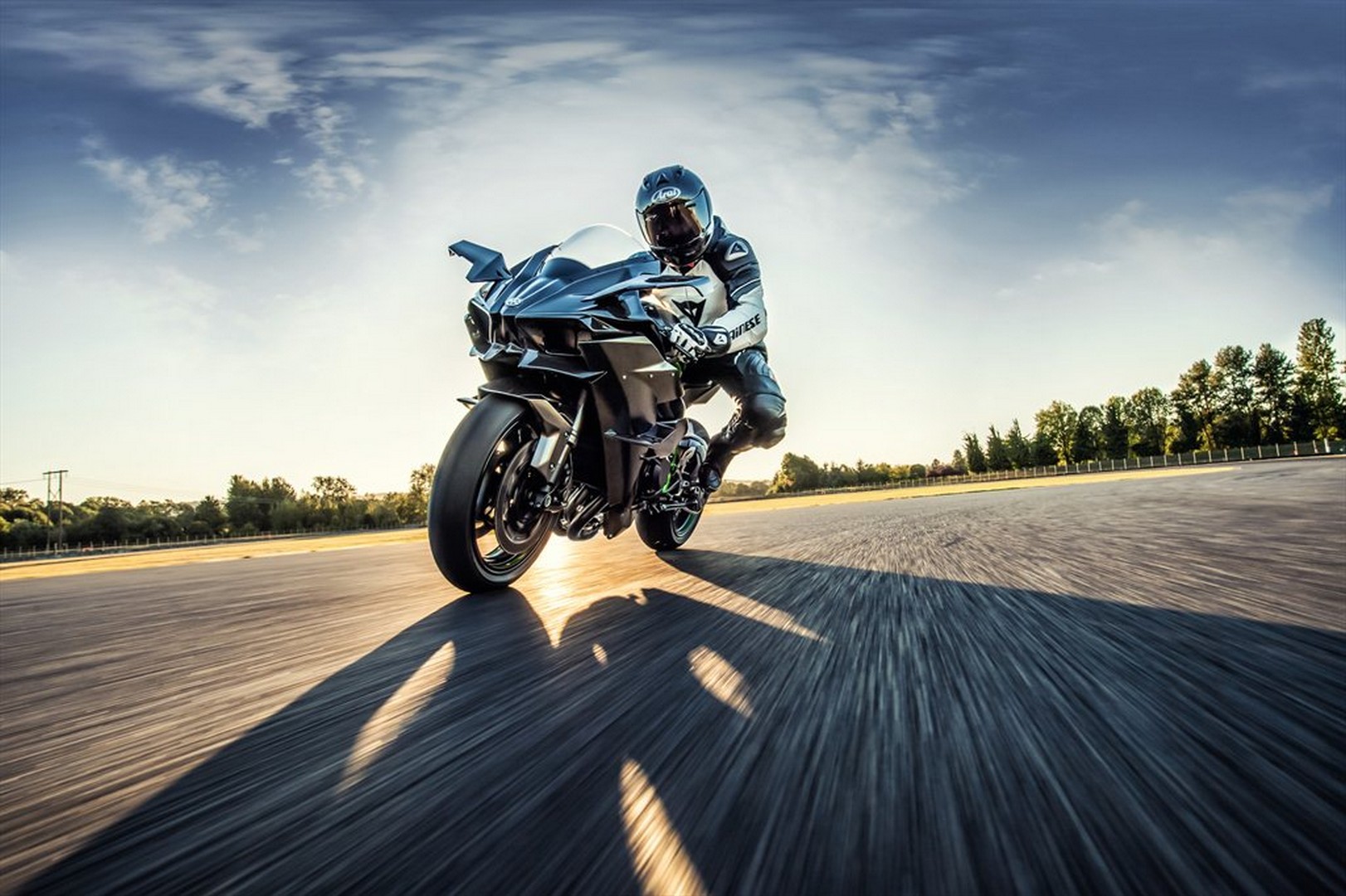

Model Overview
General Info
- Price: $57,500 USD / $66,900 CAD
- Key Features:
- ABS/Launch Control/Quick Shifter
- 998cc supercharged engine
- Dual radial-mount, 4-piston Brembo calipers
- Inverted fork, Ohlins rear shock
Main Specs
- Engine: 998cc, liquid-cooled, 4-stroke, DOHC 16-valve in-line four
- Power: 310 horsepower
- Torque: 121 lb-ft
- Weight: 476 lbs (216 kgs)
- Seat Height: 32.7 inches (830 mm)
Competitors
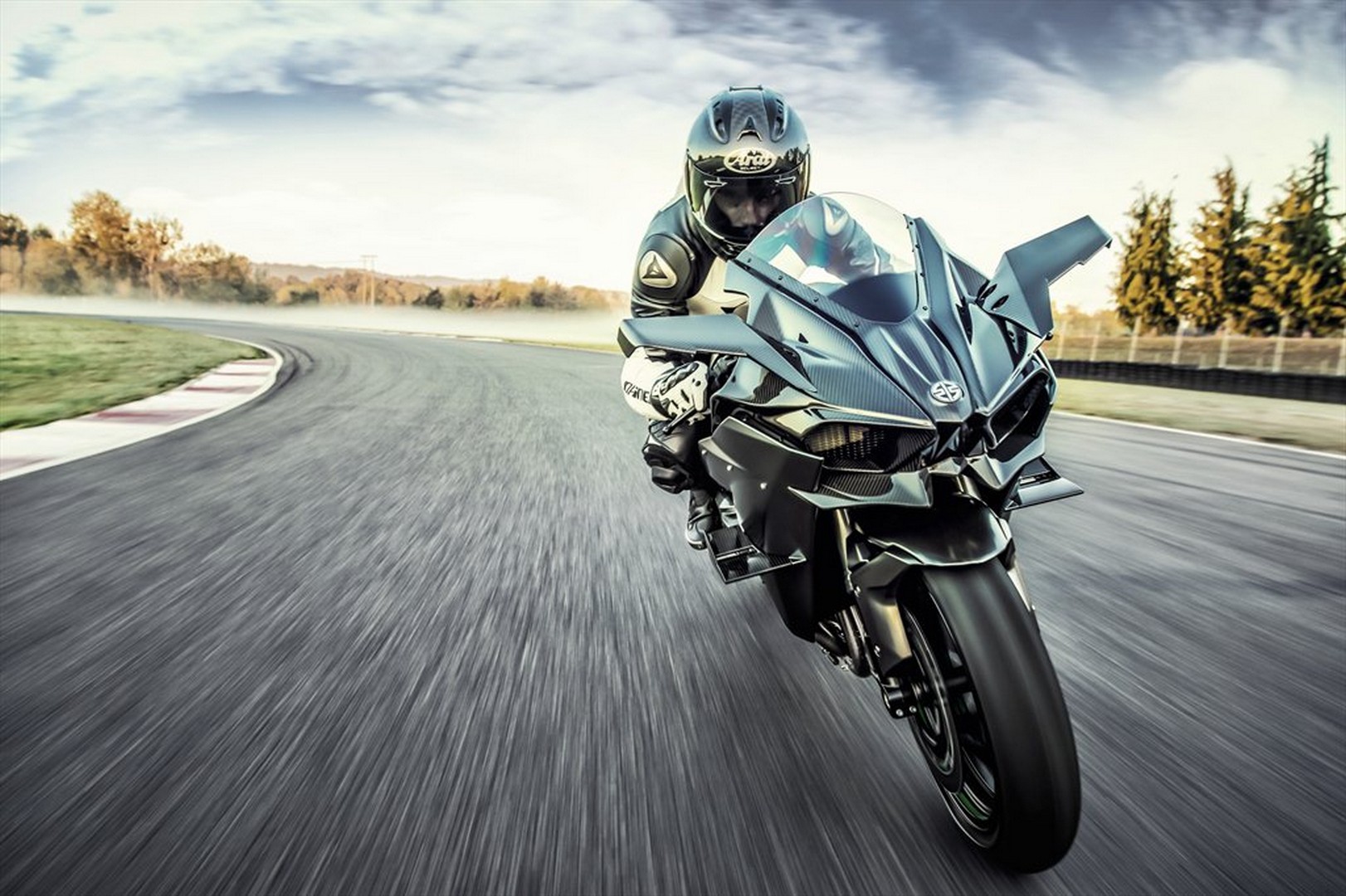

2023 Kawasaki Ninja H2R Specifications
ENGINE | |
| Engine | 998 cc Liquid -cooled, 4-stroke, In-Line Four, DOHC, 16-valve |
| Power | 310 HP |
| Bore x Stroke | 76.0 x 55.0mm |
| Compression Ratio | 8.3:1 |
| Fuel System | DFI® with 50mm throttle bodies (4) with dual injection ; Kawasaki Supercharger |
| Starter | Electric |
| Lubrication | |
DRIVETRAIN | |
| Clutch | Wet multi-disc, manual |
| Transmission | 6-speed, return, dog-ring |
| Final Drive | Sealed chain |
CHASSIS | |
| Suspension Front | 43mm inverted fork with adjustable rebound and compression damping, spring preload adjustability and top-out springs/4.7 in |
| Suspension Rear | Uni-Trak®, Öhlins TTX36 gas charged shock with piggyback reservoir, 30-way compression and rebound damping and adjustability, and hand-turn spring preload adjustability and top-outspring/5.3 in |
| Brakes Front | Dual radial-mount, opposed 4-piston Brembo Stylema® calipers, dual semi-floating 330mm discs, KIBS ABS |
| Brakes Rear | Opposed 2-piston calipers, single 250mm disc, KIBS ABS |
| Tires Front | 120/60 ZR17 V01F slick |
| Tires Rear | 190/65 ZR17 V01R slick |
| Fuel Tank Capacity | 4.5 gal |
| Color | Mirror Coated Matte Spark Black |
ELECTRICAL | |
| Ignition | Digital |
| Spark Plugs | |
| Headlight | LED |
| Tail Light | LED |
DIMENSIONS | |
| Overall Length | 81.5 in |
| Overall Width | 33.5 in |
| Overall Height | 45.7 in |
| Wheelbase | 57.1 in |
| Ground Clearance | 5.1 in |
| Seat Height | 32.7 in |
| Curb Weight | 476.3 lb* |
WARRANTY | |
| Warranty | 12 Months |
| Kawasaki Protection Plus | 12, 24, or 36 months |
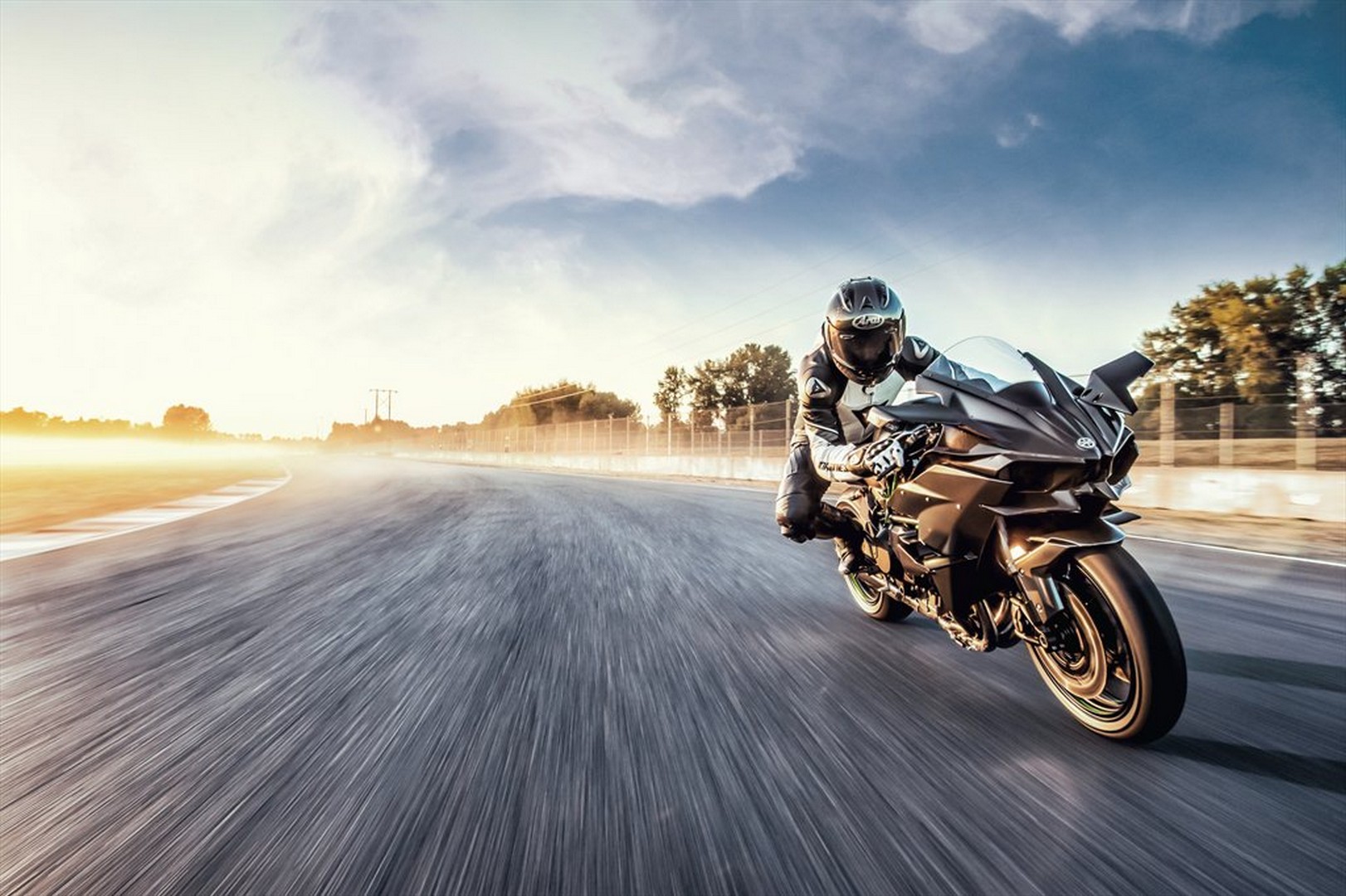

2023 Kawasaki Ninja H2R Features
Economical Riding Indicator
Using high-precision electronic control for engine management, Kawasaki models can achieve a high level of fuel efficiency. However, fuel consumption is greatly affected by throttle use, gear selection, and other elements under the rider’s control. The Economical Riding Indicator is a function that indicates when current riding conditions are consuming a low amount of fuel. The system continuously monitors fuel consumption, regardless of vehicle speed, engine speed, throttle position and other riding conditions. When fuel consumption is low for a given speed (i.e. fuel efficiency is high), an “ECO” mark appears on the instrument panel’s LCD screen. By riding so that the “ECO” mark remains on, fuel consumption can be reduced.While effective vehicle speed and engine speed may vary by model, paying attention to conditions that cause the “ECO” mark to appear can help riders improve their fuel efficiency – a handy way to increase cruising range. Further, keeping fuel consumption low also helps minimize negative impact on the environment.
Electronic Throttle Valves
Kawasaki’s fully electronic throttle actuation system enables the ECU to control the volume of both the fuel (via fuel injectors) and the air (via throttle valves) delivered to the engine. Ideal fuel injection and throttle valve position results in smooth, natural engine response and the ideal engine output. The system also makes a significant contribution to reduced emissions.
Electronic throttle valves also enable more precise control of electronic engine management systems like S-KTRC and KTRC, and allow the implementation of electronic systems like KLCM, Kawasaki Engine Brake Control, and Electronic Cruise Control.
Kawasaki Engine Brake Control
The Kawasaki Engine Brake Control system allows riders to select the amount of engine braking they prefer. When the system is activated, the engine braking effect is reduced, providing less interference when riding on the track.
KLCM (Kawasaki Launch Control Mode)
Designed to assist riders by optimizing acceleration from a stop, KLCM electronically manages engine output to minimize wheel spin when moving off. With the clutch lever pulled in and the system activated, engine speed is limited to a determined speed while the rider holds the throttle open. Once the rider releases the clutch lever to engage the clutch, engine speed is allowed to increase, but power is regulated to minimize wheel spin and help keep the front wheel on the ground. The system disengages automatically once a predetermined speed has been reached, or when the rider shifts into third gear. Depending on the model, riders can choose from multiple modes, each offering a progressively greater level of intrusion.
ABS (Anti-lock Brake System)
Kawasaki ABS systems use front and rear wheel sensors to constantly monitor wheel speed. Should information from either of the sensors indicate that wheel lock has occurred, the ABS ECU directs the pump in the ABS unit to modulate brake fluid pressure (releasing and reapplying pressure so that traction can be regained) until normal operation resumes. ABS offers rider reassurance that contributes to greater riding enjoyment.ERGO-FIT
Proper fit is key for rider comfort and control. However, the ideal fit varies from rider to rider, depending on their physical dimensions and riding style.
ERGO-FIT® is an interface system designed to allow riders to find their ideal riding position. Various points of the chassis interface (the handlebar, footpegs and seat, etc.) can be adjusted through a combination of interchangeable parts and parts with adjustable positions. This enables a wide range of riders to find a riding position that offers both comfort and control. Feeling at one with their machine, they will be able to experience how Kawasaki machines are fun and rewarding to ride.
*Adjustable parts and their range of adjustability vary by model.
IMU-Enhanced Chassis Orientation Awareness
The strength of Kawasaki’s cutting-edge electronics has always been the highly sophisticated programming that, using minimal hardware, gives the ECU an accurate real-time picture of what the chassis is doing. Kawasaki’s proprietary dynamic modeling program makes skillful use of the magic formula tire model as it examines changes in multiple parameters, enabling it to take into account changing road and tire conditions.
The addition of an IMU (Inertial Measurement Unit) enables inertia along 6 DOF (degrees of freedom) to be monitored. Acceleration along longitudinal, transverse and vertical axes, plus roll rate and pitch rate are measured. The yaw rate is calculated by the ECU using Kawasaki original software. This additional feedback contributes to an even clearer real-time picture of chassis orientation, enabling even more precise management for control at the limit.
With the addition of the IMU and the latest evolution of Kawasaki’s advanced modeling software, Kawasaki’s electronic engine and chassis management technology takes the step to the next level – changing from setting-type and reaction-type systems to feedback-type systems – to deliver even greater levels of riding excitement.
KIBS (Kawasaki Intelligent anti-lock Brake System)
Kawasaki developed KIBS to take into account the particular handling characteristics of supersport motorcycles, ensuring highly efficient braking with minimal intrusion during sport riding. It is the first mass-production brake system to link the ABS ECU (Electronic Control Unit) and engine ECU.
In addition to front and rear wheel speed, KIBS monitors front brake caliper hydraulic pressure, throttle position, engine speed, clutch actuation and gear position. This diverse information is analyzed to determine the ideal front brake hydraulic pressure. Through precise control, hydraulic pressure is modulated in much smaller increments than with standard ABS systems. The system limits rear wheel lift under heavy braking and takes downshifting into account while braking, allowing the rider to manage the rear brake. And because of the finer control, kickback to the brake lever is minimal, resulting in a very natural feeling.
Silver-Mirror Paint
Kawasaki’s high-quality original paint has a highly reflective, glasslike metal appearance. Its debut on the 2015 Ninja H2

In the shade the paint has the appearance of its base coat color, but once in the sunlight its highly reflective surface takes on the appearance of the surrounding scenery. The stark difference in the way the paint appears in the light and the shade emphasizes the sculpted shape of the bodywork on which it is applied.
The highly reflective surface is created by inducing a silver mirror reaction (a chemical reaction between a solution of silver ions and a reducing agent) that forms a layer of pure silver (Ag). This Ag layer is what creates the paint’s glasslike metal appearance. Compared to candy paints, which use aluminum flakes to generate a sparkling effect, the Ag layer appears as a uniform metallic surface.
In the shade the Ag layer is translucent, allowing the base coat color to show through. This gives the paint a deep, three-dimensional quality.
While the multiple layers of paint on typical mass-production models are done by robot painters, for this silver-mirror paint each layer – from primer to clear coat – is carefully finished by the hands of Kawasaki craftsmen to ensure a flawless, lustrous surface.
2023 Kawasaki Ninja H2R Photos

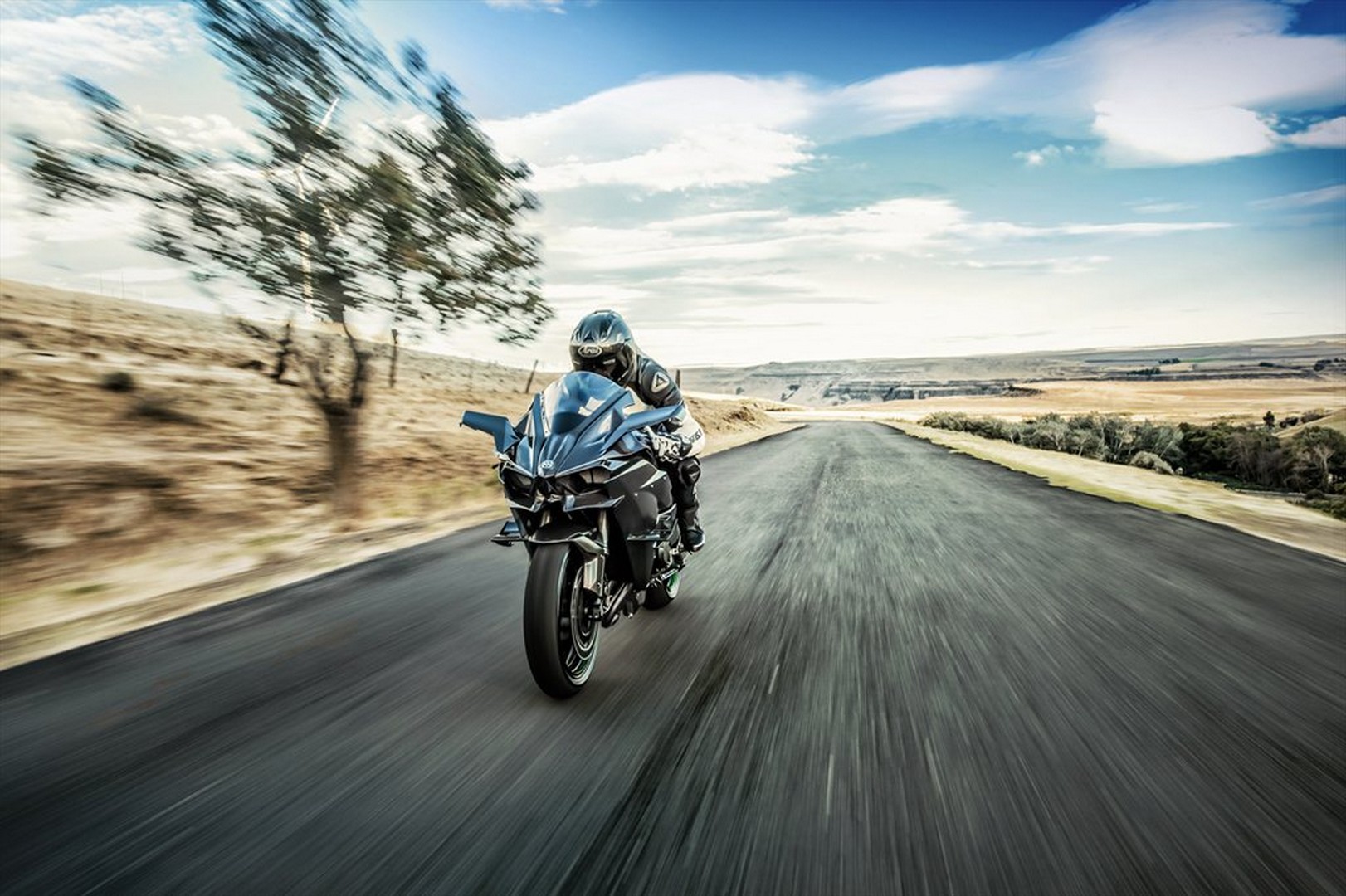


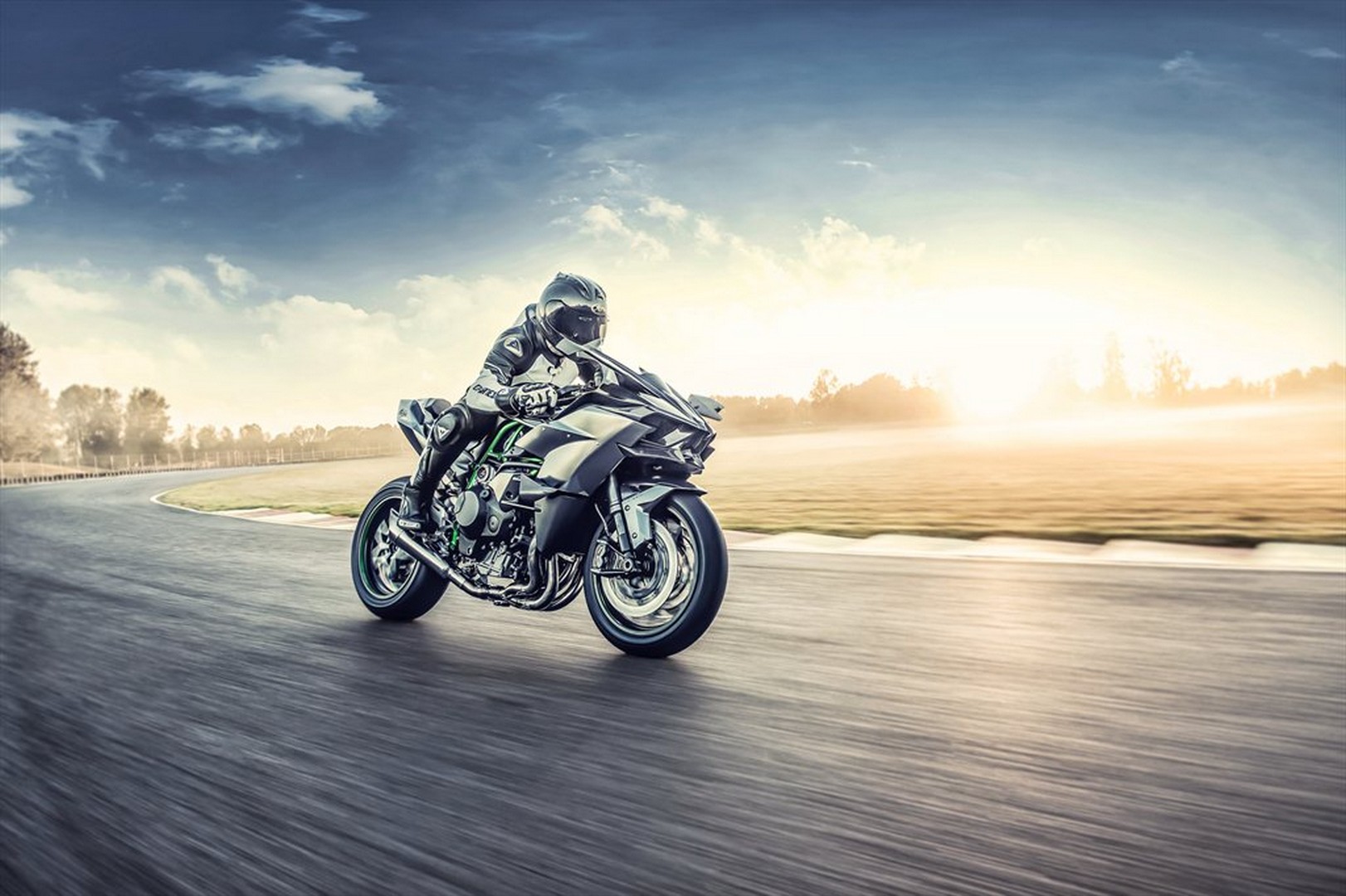
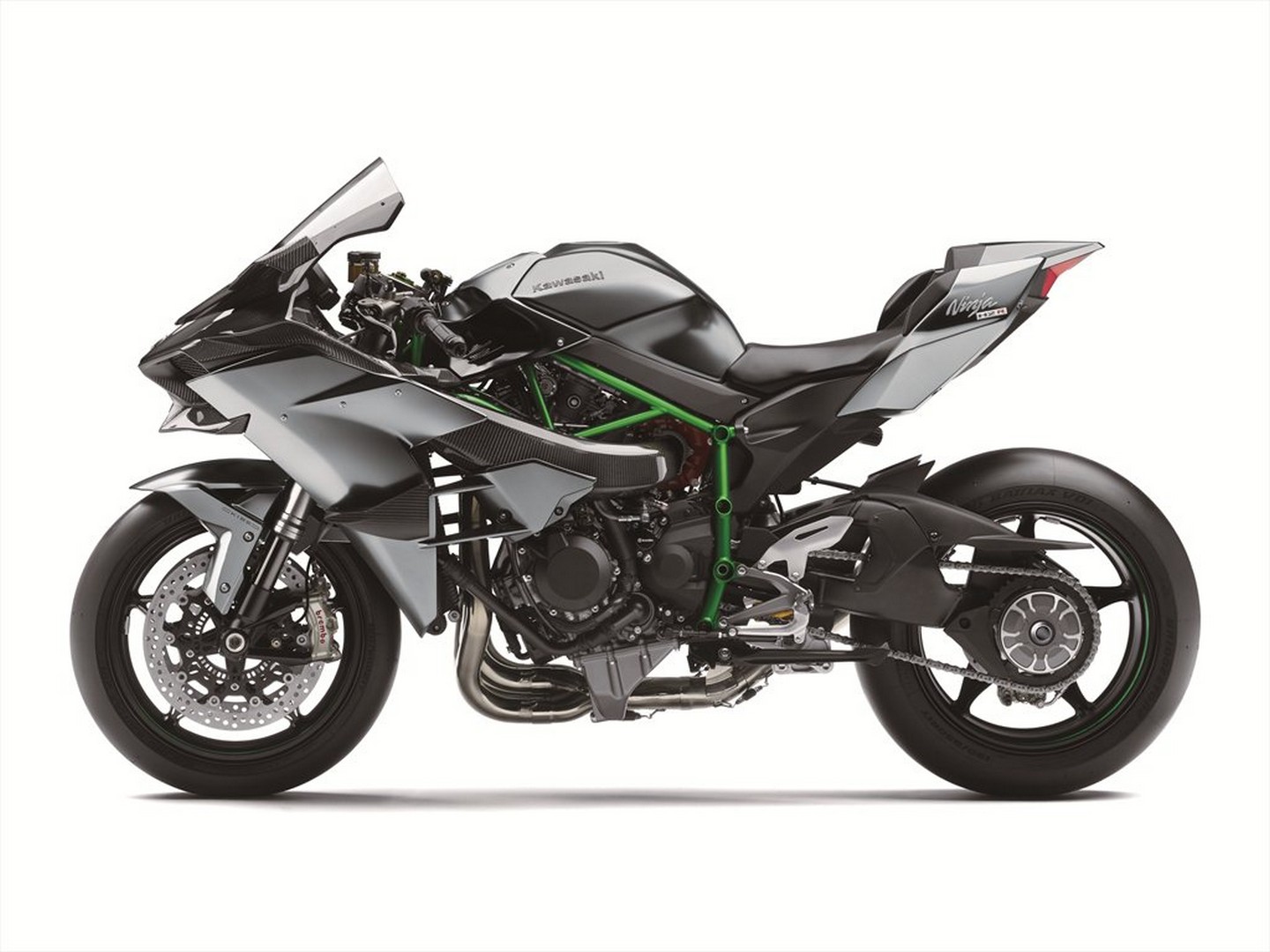
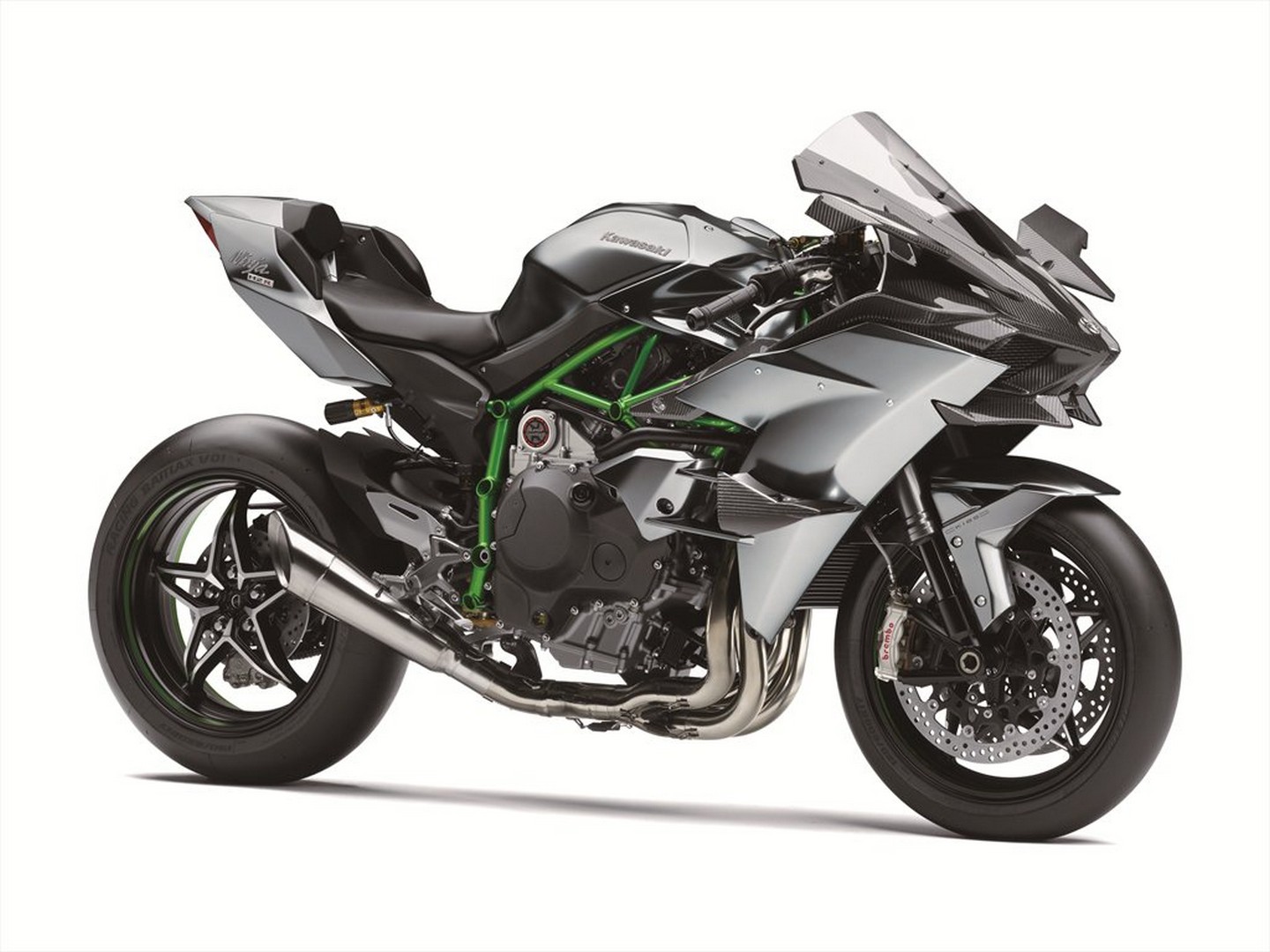
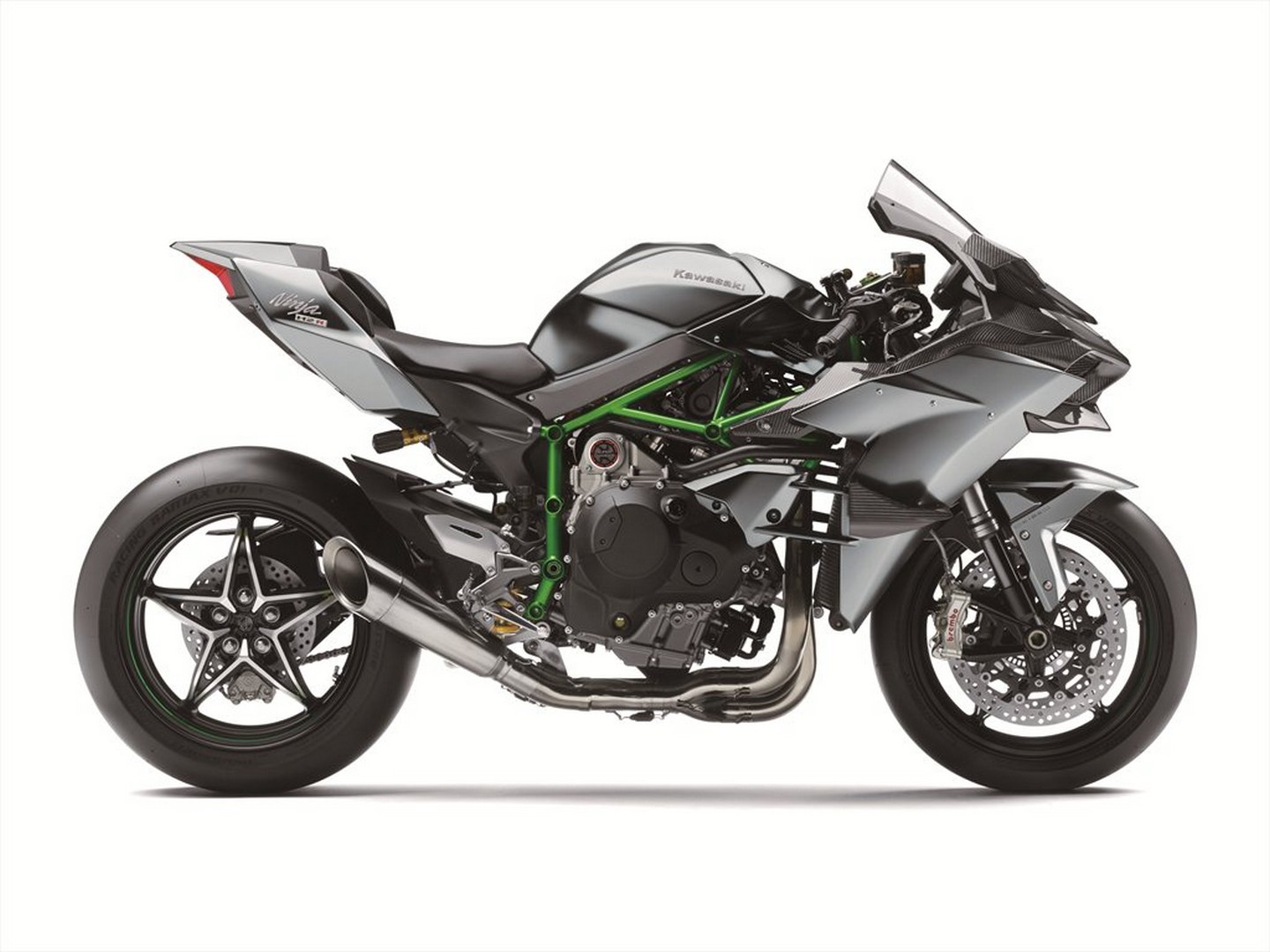
2023 Kawasaki Ninja H2R Videos
2023 Kawasaki Ninja H2R review by JoeSTi:
2023 Kawasaki Ninja H2R Review by Bikers Club:
Links
Kawasaki Official Websites
Social Media Links
The post 2023 Kawasaki Ninja H2R [Specs, Features, Photos] appeared first on webBikeWorld.
Continue reading...


